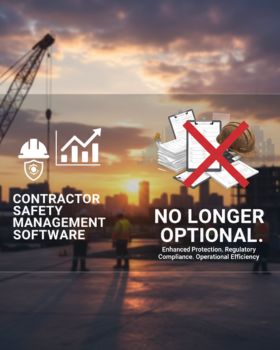
Contractor compliance is a critical component of modern operations, particularly in industries where health, safety, and environmental standards can never be compromised. Too often, organizations mistake contractor compliance for a mere administrative formality—just more paperwork to shuffle through before work can begin. However, this perception is dangerously outdated.
Manual compliance methods leave businesses exposed to unnecessary risks. Relying on spreadsheets, paper-based documents, and disjointed communications creates bottlenecks and blind spots. These outdated processes can lead to regulatory breaches, missed inspections, unqualified contractors entering the site, or worse—serious incidents resulting in injuries or fatalities.
What organizations need instead is a robust contractor management system that ensures every contractor, vendor, and service provider meets your company’s standards before they even step foot on-site.
Beyond Paper: What Contractor Compliance Really Means
Compliance isn’t just about keeping files in order. It’s about proactive risk management—ensuring contractors are competent, qualified, and aligned with your company’s safety policies before any work begins. A comprehensive contractor management approach helps organizations mitigate risks related to:
- Unsafe work practices
- Non-compliance with local or international regulations
- Incomplete or outdated permits and certifications
- Inadequate training or onboarding
- Gaps in communication and supervision
Contractor compliance is a continuous lifecycle, not a one-time checkbox. It must be built into every stage of the contractor engagement—from onboarding and training to document submission and site access.
Why Manual Processes Put You at Risk
Managing contractors manually might seem feasible when you only have a few service providers. But as operations scale, these processes quickly become unmanageable. Manual methods are prone to:
- Data entry errors
- Lost documents
- Delayed approvals
- Inefficient tracking and auditing
- Difficulty proving compliance to authorities
In contrast, a dedicated contractor management software automates, centralizes, and streamlines all aspects of contractor compliance, giving safety managers and site supervisors real-time visibility and control.
Smart Compliance: The Role of Contractor Management Software
Digital compliance systems are transforming how businesses manage contractors and mitigate risk. With contractor software, organizations can move beyond reactive paperwork and implement proactive, standardized procedures that promote safety and accountability.
Here’s how a smart contractor management system supports compliance:
- Work Permit Automation
No more printing, scanning, or chasing signatures. Automated systems generate, route, and track work permits electronically. Site managers can set parameters such as job type, location, risk level, and safety checks. Only when all conditions are met does the permit get issued.
- Real-Time Document Validation
A good contractor software platform checks submitted documentation—insurance, certifications, licenses—for authenticity, expiry, and relevance. Non-compliant or outdated documents are flagged immediately, and access can be restricted.
- SHEQ Compliance Tracking
SHEQ (Safety, Health, Environment, and Quality) indicators are central to any compliance program. Modern systems track SHEQ metrics across the contractor lifecycle, giving organizations the data they need to identify trends, improve training, and prevent incidents.
- Contractor Vetting and Prequalification
You can’t afford to onboard unverified contractors. A contractor management system ensures every individual and company is prequalified based on your criteria—experience, safety history, insurances, and certifications. This pre-qualification process helps build a safer, more compliant workforce.
- Safety Protocols and Training Integration
Compliance is closely tied to training. With the right contractor software, you can ensure all contractors undergo mandatory safety induction training before entering the site. Some systems even include quizzes or tests to confirm understanding before access is granted.
Compliance Comes Before Site Access
Letting a contractor on-site without verified compliance is like handing someone your car keys before confirming they know how to drive. Unsafe. Irresponsible. Potentially catastrophic.
That’s why compliance must come before access. A well-configured contractor management system creates automatic checkpoints to ensure:
- Only compliant workers get access badges
- Expired certifications trigger alerts
- Unqualified contractors are blocked from entering high-risk zones
- Site-specific hazards are acknowledged before work begins
This digital-first approach helps enforce a culture where safety and compliance are non-negotiable.
Set the Standards THEN Ensure Safety
You cannot enforce what you haven’t defined. Organizations must set clear, measurable compliance standards that are communicated to all contractors. These standards should be embedded into the contractor management software through automated workflows, audit trails, and escalation procedures.
The result? A safer, more efficient work environment where every stakeholder—from subcontractors to project managers—is aligned.
Why Compliance Is a Team Effort
Contractor compliance isn’t just the responsibility of the safety officer. It requires collaboration between HR, procurement, project management, and legal teams. By using an integrated contractor management system, these departments can:
- Share contractor performance data
- Align on vetting criteria
- Collaborate on training needs
- Streamline contract renewals
A unified approach reduces confusion and reinforces the importance of compliance across the organization.
Conclusion: Power Up Your Compliance Strategy with the Right Tools
Contractor compliance can no longer be treated as an afterthought or reduced to a stack of dusty files in an office cabinet. It demands attention, strategy, and the right tools to execute effectively.
That’s where contractor management software and a well-defined safety program for contractors come in. These systems not only reduce administrative burdens but also improve compliance rates, reduce incidents, and strengthen regulatory readiness.
Whether you’re managing a few subcontractors or hundreds across multiple sites, investing in contractor software is a smart, future-proof move. It enables:
- Centralized document control
- Automated work permits and onboarding
- Real-time compliance visibility
- Integrated safety training and inductions
Don’t wait for an incident to rethink your strategy. Empower your compliance efforts with a powerful contractor management system designed to make safety the standard, not a surprise.
Set your standards. Enforce your protocols. Protect your people.
It’s not just about ticking boxes—it’s about building a safer, smarter future for everyone on your site.
🔗 Learn more at sheqnetwork.com and transform the way you manage contractor safety today.
👉 Ready to see it in action? Book your free demo here!
Ready to transform? Contact us today at info@sheqnetwork.com or call us at +353 21 4536034 for a personalized demo!




One Comment